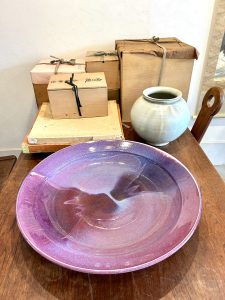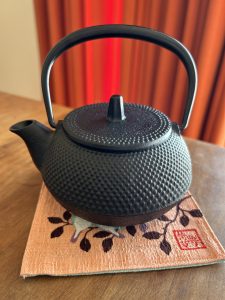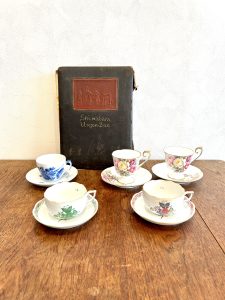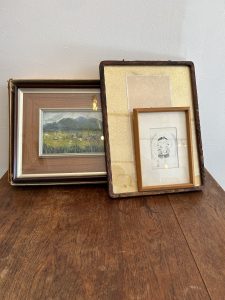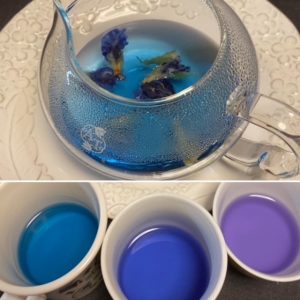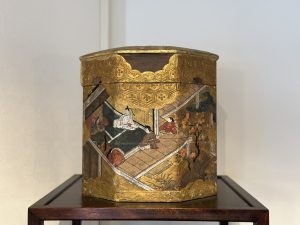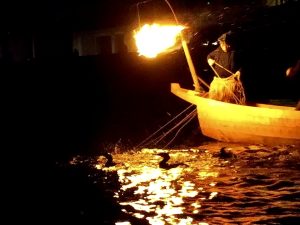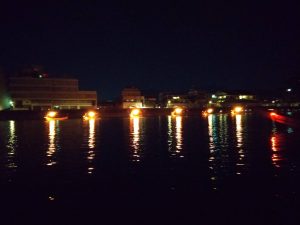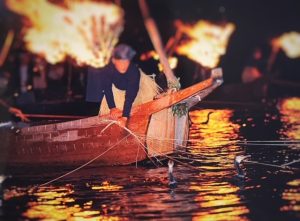魅惑の光を放つガラス(愛知県名古屋市千種区 骨董買取 古美術風光舎)
2023.06.20
みなさまこんにちは。スタッフKでございます。
今年の梅雨入りは例年より早めで梅雨明けも早めとの予想ですが、このまま梅雨が明けてしまいそうな夏日が続いておりますね。水分補給を心掛け体調管理を気を付けたいですね。
さて、暑い季節になりますと、ガラスの器や工芸品に目が向いてしまうのですが、風光舎名古屋店のギャラリーに並んでいる古美術品の中にパッと目を引く黄緑色のガラスの器があります。全体的には薄い黄色と黄緑で、切り口や底の厚みのある部分は濃い黄緑色に輝いています。

少し気泡も見られ丸みのあるレトロな雰囲気を纏ったこのガラスの器は「ウランガラス」というガラスで出来ています。
ウランと聞きますと、少々怖い気も致しますが、一体どんなガラスなのでしょうか。
ウランガラスとは、ガラスの原料着色剤としてごく少量のウランを混ぜたもので、最大の特徴は真っ暗なところで紫外線ランプ(ブラックライト)で照らすと妖艶な緑色の蛍光を発することです。ごく微量ということと、ガラスに閉じ込められているということで、ウランガラスそのものの人体への影響はほとんどないとのことです。
ウランガラスが最初に発明されたのは1830年代のボヘミア地方です。当時は人工的に紫外線を照射する技術が存在しておりません。それなのにどうしてウランガラスが蛍光を発することがわかったのでしょうか。
黄色を出すための発色剤がウラン化合物であったこと、夜明け前の空が青い時は空に紫外線が満ちていること、この二つの条件が重なって偶然発見されたそうです。当時の人々は、ウランガラスで出来た食器や調度品を朝焼けや夕焼けの光を当てて蛍光を鑑賞していたようです。
人工的なブラックライトではなく、自然現象の中で発光を鑑賞するってなんだか素敵ですね。
1830年代以降ボヘミア地方のヨーロッパ各国やアメリカで盛んに製造されていたウランガラス製品ですが、ウランが原子力に利用されるようになった1940年代以降はほとんど製造されなくなってしまいましたが、現在は一部のコレクターに向けてチェコやアメリカで僅かに生産されるのみだそうです。
ヨーロッパ発祥のウランガラスですが、日本では製造されていたのでしょうか。
調べてみますと、東京の岩城硝子の創始者である岩城瀧次郎が明治33年(1900年)にアメリカよりウランガラスの製造法を持ち帰り、大阪の島田硝子(戦後東洋硝子に変更)の創始者・島田孫一に伝授して明治34年ごろから製造が始まったとされています。
その他、日本最古の硝子会社とされている愛知の石塚硝子などがウランガラスの製品を製造していましたが、昭和16年(1941年)にアメリカがウランの輸出を禁止したため原料が入手できなくなったことと、第二次世界大戦がはじまったことでウランガラスの製造は途絶えてしまいました。
このような歴史背景により、ウランガラス製の食器や調度品は外国製のものだと1830年代から1940年代のおよそ100年間、日本製だと大正時代から昭和初期(1920代から1930年代)という限られた期間にだけ量産された貴重なものであることがわかり、骨董品として大変価値があるとされています。
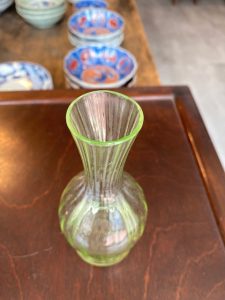
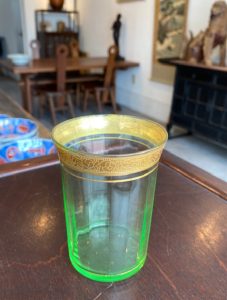
今もなお多くの人々が魅了され続けているウランガラスで出来たこちらの徳利(日本製)とコップ(外国製)は風光舎のホームページにて詳細ご覧いただけます。もちろん店頭でもご覧いただけますので是非見にいらっしゃってくださいませ。
それではまたお会いしましょう。
Hello everyone. This is Staff K.
This year’s rainy season is expected to start earlier than usual and end earlier than usual, but the summer days are continuing as if the rainy season is about to end. We need to take care of our health condition by keeping hydrated.
In the hot season, my attention is drawn to glassware and handicrafts, and among the antiques in the gallery at Fukosha Nagoya, there is a yellowish green glassware that catches my eye. The overall color is pale yellow and yellowish green, but the cut edges and the thicker part of the bottom are shining dark yellowish green.
The glassware is made of “uranium glass,” which has a rounded, retro atmosphere with a few air bubbles.
The word “uranium” may sound a little scary, but what kind of glass is it?
Uranium glass is made by mixing a very small amount of uranium as a raw material for coloring glass, and its greatest feature is that it emits a fascinating green fluorescent light when illuminated by an ultraviolet lamp (black light) in a pitch-dark place. The greatest feature of uranium glass is that it emits a mysterious green fluorescence when illuminated by an ultraviolet lamp (black light) in a pitch-dark place.
Uranium glass was first invented in Bohemia in the 1830s. At that time, the technology to artificially irradiate ultraviolet light did not exist. So how did they know that uranium glass fluoresces?
It is said that the discovery was made by chance due to a combination of two conditions: the coloring agent used to produce the yellow color was a uranium compound, and when the sky is blue before dawn, the sky is filled with ultraviolet rays. It seems that people at that time appreciated the fluorescence of dishes and furnishings made of uranium glass by exposing them to the light of morning glow and evening glow.
It is quite wonderful to appreciate luminescence in a natural phenomenon, rather than in an artificial black light.
Since the 1830s, uranium glassware has been actively manufactured in Bohemia, European countries, and the United States, but since the 1940s, when uranium was used for nuclear power, it has been almost completely discontinued. Currently, only a small amount of uranium glass is produced in the Czech Republic and the United States for a few collectors.
Uranium glass originated in Europe, but was it ever produced in Japan?
According to our research, Takijiro Iwashiro, the founder of Iwashiro Glass in Tokyo, brought back the uranium glass manufacturing method from the U.S. in 1900, and taught it to Magokazu Shimada, the founder of Shimada Glass in Osaka (changed to Toyo Glass after the war), who started manufacturing around 1901.
Ishizuka Glass in Aichi, which is said to be the oldest glass company in Japan, also manufactured uranium glass products, but the uranium glass production ceased in 1941 when the U.S. banned the export of uranium and the raw materials became unavailable. The production of uranium glass ceased with the outbreak of World War II.
Due to this historical background, tableware and furnishings made of uranium glass were mass-produced for a limited period of time: from the 1830s to the 1940s for foreign-made items, and from the Taisho Era to the early Showa Era (1920s to 1930s) for Japanese-made items. It is considered to be very valuable as an antique.
The uranium glass Tokugaru (made in Japan) and cups (made in foreign countries), which continue to fascinate many people, can be viewed in detail on the FUKOSHA website. Of course, you can also see them in our store, so please come and see them.
See you soon.
*******************
ご実家の整理やお片付けなどをされている方のご相談などが多くございます。
お片付けなどくれぐれもご無理のないようになさってくださいませ。
風光舎では古美術品や骨董品の他にも絵画や宝石、趣味のお品など様々なジャンルのものを買受しております。
お片付けをされていて、こういうものでもいいのかしらと迷われているものでも、どうぞお気軽にご相談下さいませ。
また風光舎は、出張買取も強化しております。ご近所はもちろん、愛知県内、岐阜県、三重県その他の県へも出張いたします。
まずは、お電話お待ちしております。
愛知県名古屋市千種区姫池通
骨董 買取【古美術 風光舎 名古屋店】
TEL052(734)8444
10:00-17:00 OPEN
#出張買取#骨董#古美術#骨董品#絵画#版画#茶道具#刀剣#彫刻

